How to Create Your Own Sensory Garden at Home
February 9th, 2024 | Categories
Our gardens are little private slices of nature that reflect our own personalities and likes. Maybe you’re the entertainer, and love a nice, tiled patio area with comfy rattan furniture, cushions, throws, and fire pits, or maybe you’re into the wilder natural feel and love the cottage garden look with an informal design, traditional materials, lots of lovely wildflowers mixed in with densely planted full borders, or your focus is on providing a little haven for birds and other wildlife. Or, maybe a mixture of these examples and more! The one thing any type of garden can be complimented by is adding additional layers of sensory stimulation to them.
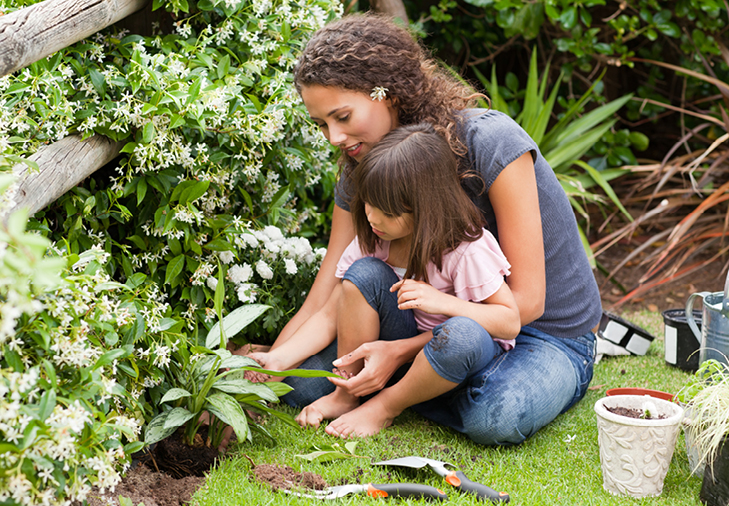
Sensory stimulation in gardening, or ‘sensory gardens’ are gardens designed to rouse some or all our five senses through scent, sight, sound, taste, and touch. They can be designed in many ways with different goals in mind, like introducing brightly coloured flowers to lift our moods, or beautifully scented plants to calm anxieties and add interests, or perhaps adding a water feature to provide the therapeutic sound of trickling water, or even growing your own fruit, veg, and herbs to touch and taste, not to mention for the sense of achievement because you grew it yourself!
All gardens provide a sensory experience of course, but a garden with a sensory focus at its core will have several or an abundance of different elements – plants, surfaces, objects, sounds, life – that stimulate and engage several of our senses. They are a fantastic way to help calm us from the stresses of modern life, but even better they can be educational spaces for our children and young people to learn about nature and new skills, help those who are suffering from mental ill-health, and aid those with cognitive impairments, and additionally people with autism. Sensory gardens can make a positive impact to the health and wellbeing of us all.
In this guide, we will explore more of what makes a sensory garden, well, sensory, and give easy ideas you can readily use to introduce sensory areas with a few simple additions. As mentioned, chances are most of our gardens have some sensory aspect already, but with a little planning and know-how they can be developed into a magical sensory escape for ourselves, our children, friends, and family. Let us show you how!
The Benefits of Sensory Gardens
So why give the garden a sensory focus at home? Well as mentioned above, they offer a range of benefits to our health and wellbeing as all gardens do, as does being outdoors generally. However, a sensory garden can provide a more planned therapeutic environment in which to relax, destress, reconnect with nature, and learn new skills. The different textures, colours, scents, sounds, and tastes all work together to create a multi-sensory experience that can improve mood, reduce anxiety, and promote feelings of happiness. They can also be particularly beneficial for people with disabilities, as the garden provides a safe and accessible space for them to engage in gardening activities.
Specifically, for children with ADHD, sensory gardens can offer a kaleidoscope of stimuli that can be incredibly beneficial. These enchanting gardens engage all the senses in a soothing symphony of textures, scents, and colours, creating a calming environment that can help reduce hyperactivity and promote focus. As they dig their hands into the soil or brush against a lavender bush, can help to ground their energy in the present moment helping them to settle, focus, and learn. Plus, the opportunity to interact with nature’s elements can also nurture their curiosity and inspire a sense of wonder as it can with any child.
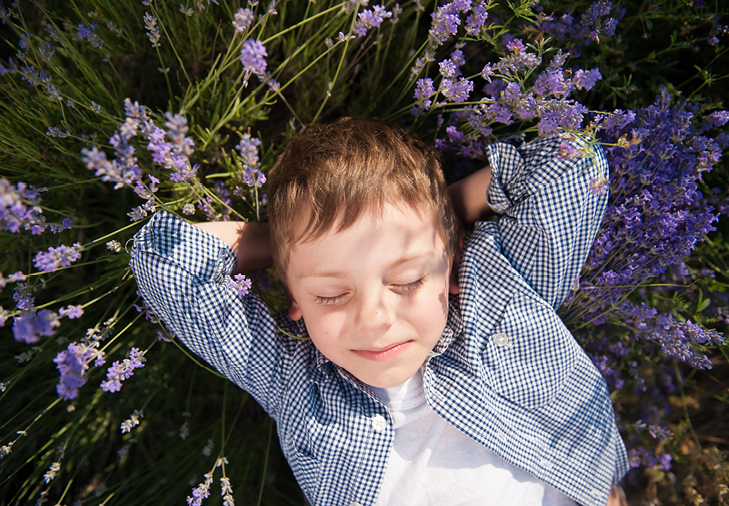
Indeed, for families with children, sensory gardens can help to take things out of the living room, where every plant and pathway offers a unique experience that’s not only a feast for their senses but also a great way of bonding together. Picture little ones giggling as they discover the soft tickle of a fern, the scent of lavender and rosemary, grandparents sharing stories by the scent of roses, or hear the buzz of bees going about their business. It’s a place where memories can be created, and the hustle and bustle of life take a backseat to the simple joy of being together.
For those with visual impairments, sensory gardens are a delightful sanctuary as they provide a multi-sensory experience beyond sight. With an array of textures to touch, from smooth succulents perhaps, to feathery grasses, and a symphony of natural sounds, like the whisper of leaves and cheerful birdcalls, these gardens stimulate other senses vividly. The rich tapestry of scents, from peppermint puffs to earthy pine, can guide and engage, making the garden a place of discovery and enjoyment where vision is not a prerequisite to appreciate the beauty of nature. It’s a celebration of inclusivity, where every aroma and rustle paints a vibrant picture for the mind’s eye.
Sensory gardens really are a wonderful thing to behold. As is gardening generally and being outdoors. They act as a comprehensive health package as it were, nurturing our bodies, calming our minds, and uplifting our emotions which in today’s world is more essential than ever. With the bustling pace of life and the myriad of challenges we face, finding refuge in nature allows us to reset, rejuvenate, and reconnect with the simplicity and beauty that life has to offer.
Rousing the Five Senses in a Sensory Garden
Now it’s time to explore some of the different ways and means to give your garden more of a sensory focus and awaken the senses for all to enjoy. While there are many features to a sensory garden, just remember that plants are of course the heart and soul. Each plant or flower must be chosen for its ability to positively stimulate one or more senses with their distinctive scents, shapes, sizes, petals, and leaves.
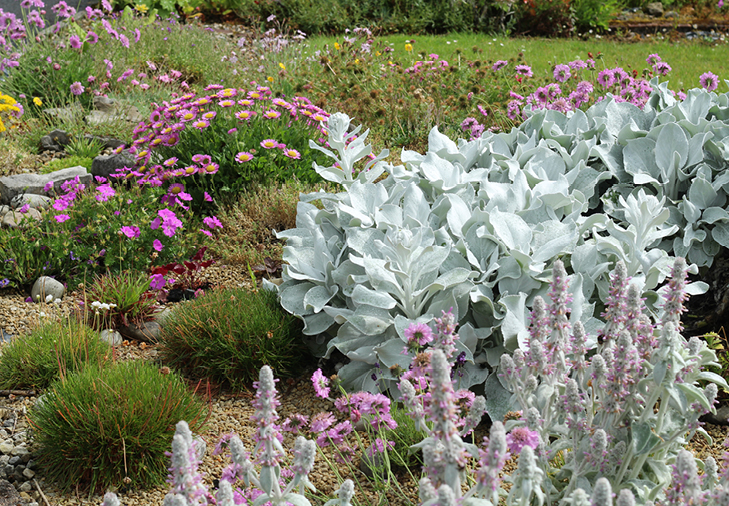
Likewise keep in mind characteristics what would be negative; we don’t want to have any plants that can irritate the skin or come with lots of barbs!
Here are some of the great ways to introduce sensory elements to your garden by focusing on each sense:
Sight
To stimulate the eyes, offer a variety of visuals that can captivate and delight visitors. This can be done using colour by planting a diverse palette; include plants with vibrant flowers, rich greens, and dramatic hues, or go for more muted calming tones. Colour therapy suggests that different colours can influence emotions and mood. For example:
- Red is a powerful colour that increases energy by stimulating the lymphatic system.
- Orange is associated with our mind and body connection.
- Yellow makes us feel warmth and happiness, even safety.
- Green makes us feel happy and gives us thoughts if being in nature among the grass, trees, and plants.
- Blue increases our sense of alertness and focus.
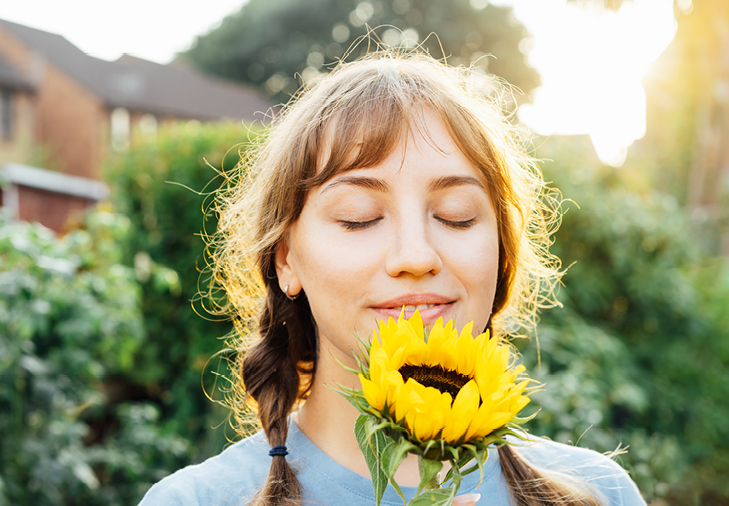
A muted, cooler palette will create a calming atmosphere whereas a warmer, vibrant palette will bring more energy to the garden. Consider seasonal changes too and choose plants that bloom or change colours throughout the seasons for year-round visual interest.
In addition to colour, consider the texture and pattern by varying foliage types. This can be done by mixing plants with different leaf shapes and variegations to create a tapestry of textures. You can also add a dynamic visual element by introducing movement and sway by planting grasses and slender flowers that move with the wind. While most plants that flower will attract pollinators, you could select plants that are particularly loved and are guaranteed to attract butterflies, bees, and other wildlife, offering a live show of natural beauty. These ideas not only serve to create a beautiful visual experience but also stimulate cognitive connections and offer educational opportunities about the natural world, right in the garden.
Smell
Our sense of smell has an undeniable power to affect our moods and mental states. Inhaling the subtle aroma of a flower or lovely aromatic plant can lift our spirits and calm anxieties. Catching a scent can conjure up memories and connections we’ve forgotten, or create new memories, feel emotions, and sensations that visual beauty cannot do alone.
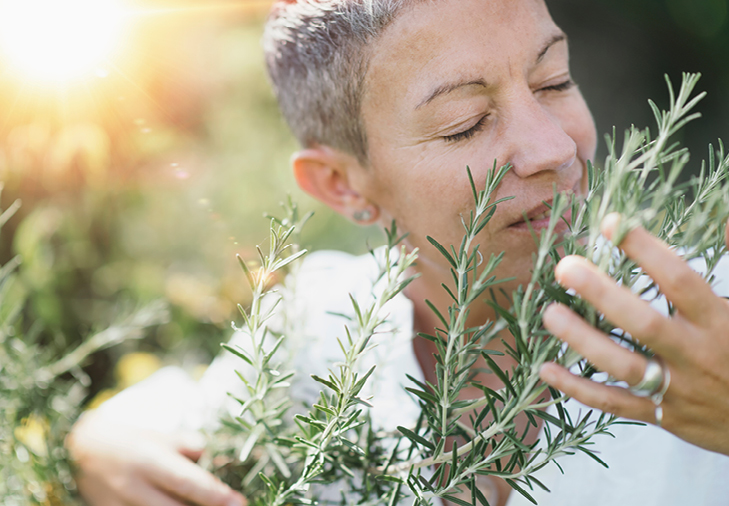
Natural aromas like lavender, pine, rosemary, mint, and many more can help reduce our stress and anxiety. The aromas interact with our limbic system, the part of the brain controlling emotions and behaviour, allowing us to think more clearly, relate more deeply, and heal more holistically.
Using fragrant plants is of course the obvious way to introduce sent to a sensory garden. But not all plants bloom at different times, which means you can ensure year-round fragrance. For example, daffodils and hyacinths in spring, lavender, roses and pelargoniums in summer, daphnes in autumn, and honeysuckle in winter would be good choices to help you achieve this.
Some plants even release their scent at night. Evening primrose or night-blooming jasmine can create a sensory experience after dusk, perfect for those who enjoy spending time in the garden during cooler evening hours.
Herbs are another great option for scent when touched. Aromatic herbs like lavender, rosemary, mint, and thyme release their scent when rubbed, encouraging interaction while providing therapeutic benefits such as relaxation and stress relief.
Incorporating wonderful scent elements into a sensory garden cultivates an environment that not only smells wonderful but makes it a restorative retreat for all who visit.
Sound
Catering to the sense of sound in a sensory garden involves incorporating natural and artificial elements that create a harmonious soundscape. This not only enhances the overall sensory experience but can also foster relaxation, concentration, and a deeper connection with nature.
Natural Sounds can be introduced using bamboo or tall ornamental grasses rustling soothingly when the wind blows through them. Additionally, flowers like poppies or deciduous trees like acers will drop their leaves in the autumn which will dry creating gentle crackling sounds as they blow along the ground or are stepped on.

As mentioned, water features are a fantastic choice as the sound of trickling and flowing water is universally calming. As an added bonus is can mask unwanted noises from the surrounding environment
Adding bird and pollinator friendly plants will add another layer of natural sound from the wonderful morning birdsong to the mid-afternoon buzzing of bees to sooth the mind and provide wonderful interest. Choose berry-producing shrubs or seed-bearing that birds will enjoy such as include sunflowers, holly bushes, and crabapple trees. Lavender and buddleia are most loved universally by all pollinators.
And there’s also the likes of wind chimes and bells that can complement the natural sounds. Strategically placed wind chimes crafted from different materials like bamboo, metal, and glass can produce a variety of pleasant tones. The layering of sounds like these stimulates cognitive function and concentration, while also providing a therapeutic and relaxing ambiance, helping to reduce stress and anxiety. Not only that, but sound also enhances the sensory diversity of the garden, making it an inclusive space for both the visually impaired and other visitors.
By thoughtfully planning for sound in your sensory garden, you create an immersive and tranquil environment that can transport visitors away from the hustle and bustle of daily life, offering them a unique opportunity to tune in to nature’s rhythms.
Taste
Integrating edibles for taste is arguably one of the most interesting aspects of a sensory garden for a few reasons. First, eating! From fruits to veg, and herbs, there’s flavours there that everyone can enjoy.
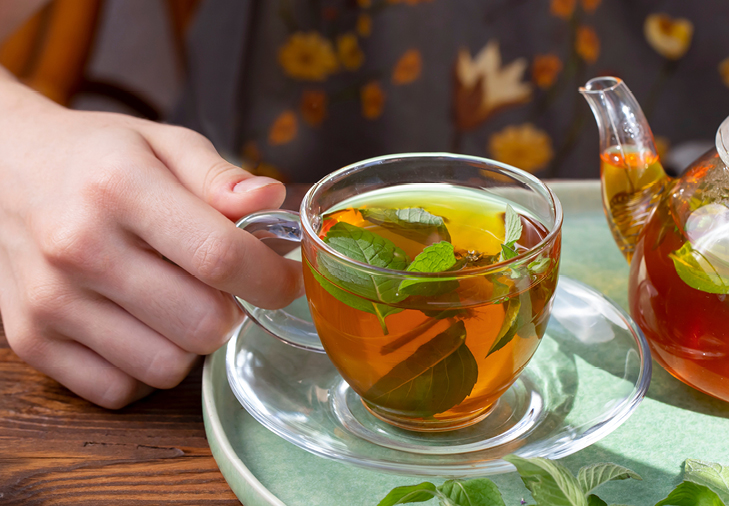
Furthermore, edible plants can provide educational opportunities about where food comes from and how it’s grown, and the different care food crops need. Lastly, the sense of achievement from growing your own in the back garden can’t be discounted and is a great feeling for adults and children alike.
Introduce a variety of herbs like basil, mint, rosemary, and parsley for visitors to sample. Herbs offer intense flavours and come with the added benefit of being easy to grow. Fruit-bearing shrubs and trees like blueberries, strawberries, or small fruit trees like dwarf apple or cherry varieties are great choices and their fruits provide sweet and tangy flavours to enjoy. A little vegetable plot in a raised bed wouldn’t go amiss too. Leafy salad greens, tomatoes, and cucumbers can be grown and easily picked.
The inclusion of taste in a sensory garden fosters a connection with nature by experiencing the cycle of growth, harvest, and of course the enjoying! It also provides hands-on educational opportunities for all ages to learn about agriculture and nutrition. By engaging the sense of taste, a sensory garden becomes not just a place of beauty and relaxation but also a living classroom where you can enjoy learning about and consuming what you’ve helped to grow.
Touch
While taste may be one of the most interesting aspects, touch is certainly one of the more profound aspects.
A tactile garden creates amazing opportunities to learn about plants and their environments through hands-on exploration. Through touch, we can capability a deeper, more spiritual connection to nature, while simultaneously experiencing therapeutic benefits to our wellbeing. The different textures of plants and other natural materials can stimulate memories and emotions, helping to create a more memorable and personal experience.

Exploration can be encouraged by including different plants that have different textures. One of the best is lamb’s ear which has soft, velvety leaves that are enjoyable to gently stroke. The rough bark of a tree and sponginess of moss can provide a stark but fun contrast to one another. Touch and scent can combine again with choisya plants that have scented leaves like basil when rubbed.
Touch can also be incorporated by using materials like stones and pebbles to mark out a pathway to a different part of the sensory garden. This is a wonderful contrast to the organic and softer feel of plants and grass underfoot. Likewise, being able to run a hand through cool water on a sunny day is a refreshing and fun bonus.
By providing a diverse range of textures and interactive elements, a sensory garden becomes a multifaceted space that educates, makes us feel calm, engages positive emotions, and stimulates the formation of new memories while helping to recollect old ones. Truly amazing.
Introduce Sensory Elements to Your Own Garden

Wow! Sensory gardens are a wonderful thing indeed. They offer a unique opportunity to engage with nature in a way that stimulates all the senses, providing a myriad of benefits ranging from emotional well-being to cognitive stimulation. What’s truly remarkable is the accessibility of creating such an environment in our own gardens, with just a few thoughtful additions to our existing spaces.
By incorporating elements that cater to sight, smell, sound, taste, and touch, a garden can transform into an interactive sanctuary. Whether it’s hanging wind chimes for auditory pleasure, planting fragrant herbs for olfactory enjoyment, or designating a corner for textured plants to delight tactile senses, these simple changes can make a profound impact. Sensory gardens are a testament to the power of the natural world to nurture and heal, and their creation is an achievable endeavour for anyone seeking to enhance their connection to the outdoors.






